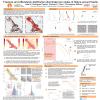Poster #168, Fault and Rupture Mechanics (FARM)
Multi-fault rupture plausibility inferences from a deterministic earthquake simulator
Poster Image:

Poster Presentation
2020 SCEC Annual Meeting, Poster #168, SCEC Contribution #10630 VIEW PDF
d were largely empirical, e.g., maximum jump distance (5 km) and maximum fault-to-fault azimuth change (60 degrees), and a physical constraint was included which assessed the Coulomb compatibility of fault section jumps (though it only evaluated ruptures at each jumping point, not their total physical consistency).
We test the UCERF3 multi-fault rupture plausibility criteria against physically-consistent synthetic seismicity catalogs generated with the Rate-State Earthquake Simulator (RSQSim) on the UCERF3 fault system. Previous studies have shown agreement between RSQSim and UCERF3 when carried through to PSHA calculations; here we examine individual ruptures in more detail. We find that RSQSim catalogs produce multi-fault ruptures at a similar rate to UCERF3, and most (>75% of M≥6.5 ruptures) pass all UCERF3 plausibility criteria. We also identify a number of plausible fault jumps which occur in RSQSim catalogs but are not allowed under the UCERF3 rules, and propose modifications to the plausibility criteria for the next UCERF model to incorporate inferences from RSQSim.
SHOW MORE
We test the UCERF3 multi-fault rupture plausibility criteria against physically-consistent synthetic seismicity catalogs generated with the Rate-State Earthquake Simulator (RSQSim) on the UCERF3 fault system. Previous studies have shown agreement between RSQSim and UCERF3 when carried through to PSHA calculations; here we examine individual ruptures in more detail. We find that RSQSim catalogs produce multi-fault ruptures at a similar rate to UCERF3, and most (>75% of M≥6.5 ruptures) pass all UCERF3 plausibility criteria. We also identify a number of plausible fault jumps which occur in RSQSim catalogs but are not allowed under the UCERF3 rules, and propose modifications to the plausibility criteria for the next UCERF model to incorporate inferences from RSQSim.
SHOW MORE




































































